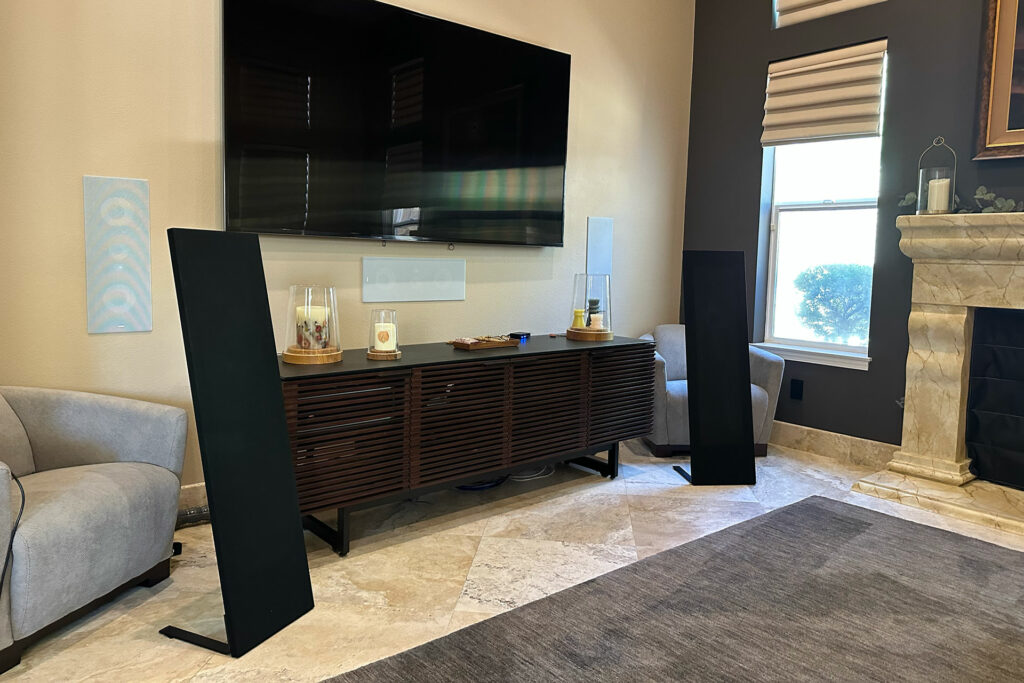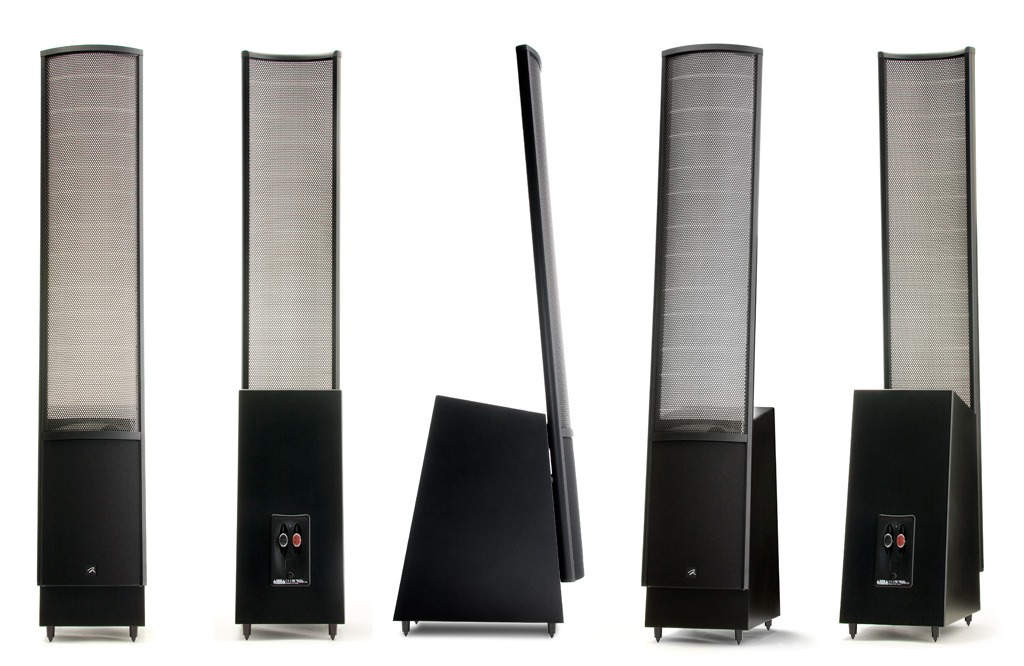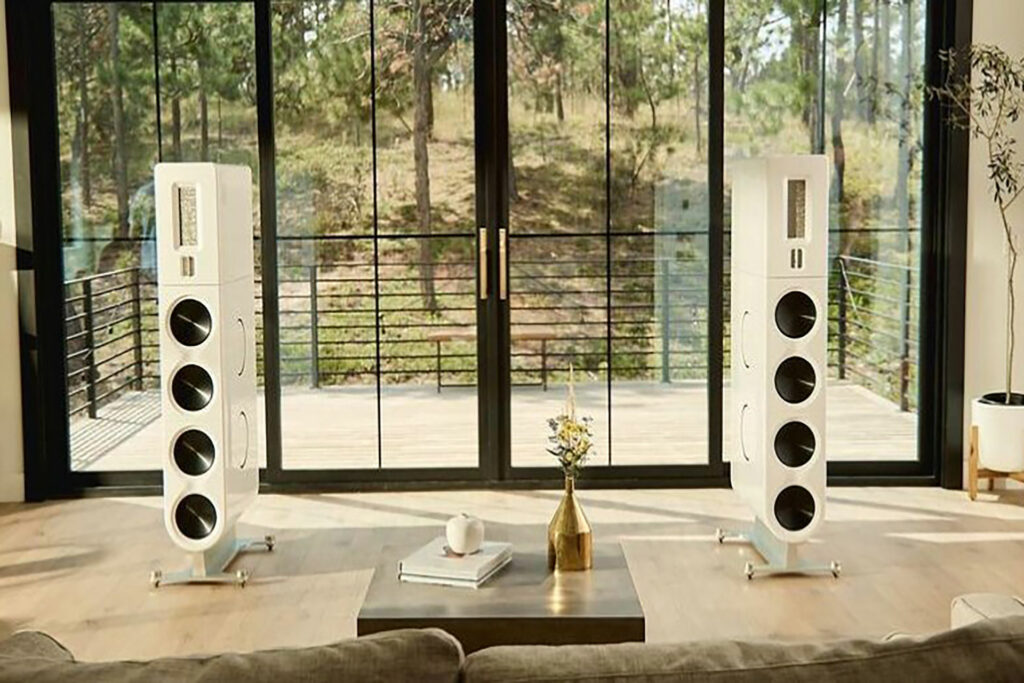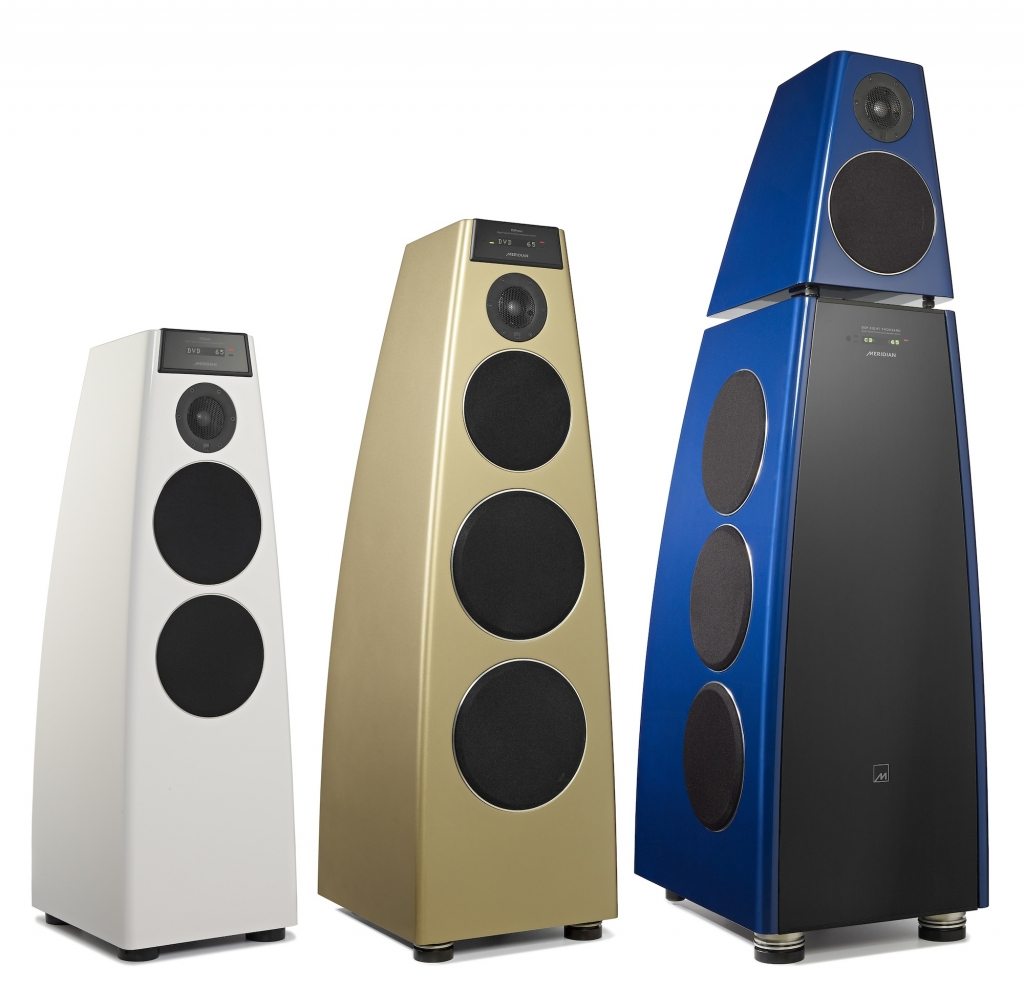Loudspeakers are somewhat of a marvel. Where electronic components are designed to efficiently move electrical signals from one place to the next, speakers have the unique job of converting those signals to the mechanical vibrations we perceive as music. Without this important capability, we would not be able to hear our favorite songs. In this, the third article in my audio basics series, we look at several (not all) popular speaker types, how they work, and each one’s associated advantages and disadvantages.

What Does an Audiophile Loudspeaker Really Do?
Whether floorstanding, bookshelf, stand mount, in-wall, ceiling mount, or even those designed for outdoors… all speakers have one principal task: to create vibrations in the air that move your eardrums. To accomplish this task, the speaker must take an electrical signal, apply that signal to a magnetic field, and move some type of a diaphragm that in turn compresses air. Each and every speaker type known to mankind, regardless of the overall design, in the end does the same thing.
Accomplishing this is a challenge and the path to high quality sonics has many roadblocks. For one, speakers must be able to accurately and realistically recreate the three principal frequency ranges: bass, midrange, and treble. Instruments and vocals must possess a believable sense of accuracy, clarity, and there must be a visceral sense of impact. Audiophiles call this impact dynamics. Most importantly, and ultimately, speakers must correctly and reliably recreate what is on the recording. No small task when you think about it.
Dynamic speakers are the most versatile and most popular in the audiophile marketplace today.
Generally speaking, dynamic speakers will deliver very respectable, clean sound and are capable of providing the listener with a realistic soundstage and image development across the frequency spectrum.
When an amplifier sends an electrical signal to a dynamic speaker, it is first delivered to a crossover. The crossover network will separate the signal from the amp into bass/midrange and treble for a two-way speaker and bass, midrange, and treble for a three-way speaker. For the drivers that create low frequencies are typically called woofers, and higher frequencies are delivered by tweeters. The frequencies in between, if they have their own dedicated drivers, might be called mid-drivers, mid-woofers, cones, or simple mids. Woofers are the largest drivers in terms of physical size; tweeters are the smallest.
After the crossover network has divided the signal into different bands, the current then energizes a voice coil built into each driver in a speaker enclosure. This current creates an expanding and collapsing magnetic field around the voice coil on the driver. Magnets in the driver create a permanent magnetic field that reacts to the expansion and collapse of the field around the voice coil. This, in turn, pushes forward and pulls back a cone attached to the voice coil and creates air movement. This air movement creates the music we hear.
Generally speaking, dynamic speakers offer the most flexibility in a listening space. They are typically the easiest to position to create adequate bass, mids, treble, dynamics, an identifiable center image, and image development in general. They broadcast sound in a somewhat conical fashion, albeit slightly more directly radiated in higher frequencies and more spread out in the lows. Dynamic speakers come in floorstanding, bookshelf/stand mount, wall or ceiling mount, and even disguised as a planter box on the patio.
The relationship of the amplifier and speaker are very important and perhaps nowhere more so than with a dynamic speaker. Amplifiers tell the speaker’s cone in the specific driver how far forward to move, when to stop forward movement, when to return to its original position and when to stop its return. Physics are involved here, because when the cone moves forward or backward, momentum wants it to keep going. This condition is called overhang and is responsible for lower quality sound. It happens to a certain extent with all dynamic speakers, so matching the amp to the speaker is therefore very important.
Amps with more than sufficient power tend to make it easier for the speaker to produce sound. Although not listed by many amplifier manufacturers, damping factor is a term to measure the level of control an amp has over the speaker’s performance. Knowing this value will help assess the quality of the amplifier/speaker relationship. It is worth mentioning all speaker designs are influenced by damping factor, not just dynamic versions.
Another drawback of a dynamic speaker is dynamic compression. As the amplitude is increased, the electrical current’s resistance to normal operation also increases. This resistance increases the amount of heat the driver is creating. This increased heat reduces the performance of the pistonic movement of the voice coil and the attached cone. Eventually, the driver cannot continue to produce the sound the increased amplifier volume wants to deliver. At that point, the driver is no longer capable of playing music any more loudly.
Because tweeters move far less air than the other drivers, compression occurs first in higher frequencies, then in midranges, and finally in woofers. It also creates significantly more distortion in the speaker’s output and is partly responsible for a congested sound. This condition will typically be first noticed in higher frequencies where a cymbal crash will have far less dynamics than a guitar or kick drum. For this reason, correctly matching the amp to a dynamic speaker is paramount.
Playing music very loudly, especially with underpowered amps, may cause the amp to clip, which may easily overload the drivers, normally the tweeter first, and possibly blow out a driver. So be careful when cranking up a favorite heavy metal band.
There is a nearly endless group of well-known dynamic speakers ranging from entry-priced offerings from Monoprice, Polk Audio, ELAC, and SVS. Paradigm, PSB, Bowers & Wilkins, Monitor Audio, Tekton Design, RBH, and so many others make excellent moderately priced dynamic speakers. On the high end, look to Wilson Audio, Magico, YG Acoustics, Focal, and again literally dozens of examples. This list doesn’t even really scratch the surface of the options for high-performance dynamic speakers.

Planar Transducers (also called a Planar Magnetic Speaker)
As mentioned above, dynamic speakers use a voice coil and magnets to generate sound. A popular alternative to this technology is the Planar Magnetic Speaker. A vertical panel – an electrically conductive thin metal strip, often pleated for strength, and usually made from aluminum – is suspended between the north and south poles of two magnets. When an electrical signal is applied to the ribbon, the permanent magnetic field alternates polarity and moves the metal strip, creating the movement of air from both the front and back. The metal ribbon functions in a very similar manner to the voice coil and diaphragm in a dynamic speaker
One principal advantage of a planar speaker is the moving mass of the thin aluminum speaker array is far less than the moving mass of a dynamic speaker’s voice coil and cone. A very thin piece of aluminum is far easier to place in motion and move air than a very heavy driver in a dynamic design. For this reason, planar speakers have an incredibly clean and clear sonic presentation.
Most commonly, the cabinet in a planar speaker is open on the front and back with only a grill mounted in a frame protecting the internal speaker parts. Planar speakers are therefore classified as dipole – meaning radiating from the front as well as the back. This lack of a formal enclosure also enhances a planar speaker’s performance. Many feel this style of speakers has a truly natural or open sound.
As might be expected, planar speakers have some notable design disadvantages. For instance, they require considerable amplifier power to be driven. This is due to low sensitivity, otherwise known as the amount of amplifier voltage required to power a speaker to a given amplitude. Another issue is positioning in a room. Because the dispersion pattern is relatively narrow, and being bipolar, a dedicated effort is required for optimal imaging. There is not much in the way of off-axis dispersion, either. This type of speakers is best used in a large listening room, with the speakers placed well into the room, due to a rather narrow broadcast pattern and radiating both from the front as well as the rear of the speaker. There is always the possibility of adverse room interactions and reflection issues with any dipole-type speaker. They also tend to be physically quite large, or can be, which may complicate matters in a smaller room. Placing them close to a wall can greatly reduce their performance, hence the need for a very large room. Lastly, planar speakers, generally speaking, have a real challenge producing low, powerful bass, or much in the way of a notable dynamic impact.
Probably their best attribute is the amazing clarity and low distortion. Dedicated fans of a planar design will be hard pressed to listen to any other type of speaker. Magnepan, or “Maggies” for short, are perhaps the best known example of planar speakers.

Electrostatic Speakers (a close cousin of planar speaker designs)
Electrostatic speakers are similar in design to a planar speaker. In an electrostatic design, a very thin, strong membrane, typically Mylar, is stretched between two metal bars. These metal bars are called stators, and when electrically energized, a fluctuating magnetic field is created. This magnetic field reacts with the fixed magnetic field of the membrane and causes it to be pushed forward and pulled back. This push-and-pull motion creates air movement and creates sound.
Very often, the flexible material, again typically Mylar, operates with very high voltages (yet very low amperage) – often as high as 10,000 volts created by step-up transformers in the enclosure. This makes electrostatic speakers susceptible to damage when played at very high amplitudes. However, the panels housing the Mylar are very light in weight and therefore stop and start very quickly. This immediacy of operation enables this design to provide a very fast, very clean presentation. They also have no formal enclosure so there are no cabinet interactions to negatively affect their performance. They produce sound equally from the rear as from the front. Like planar speakers, their abundantly clean, clear, low distortion, almost lifelike presentation is highly admired by proponents of this design.
Some more notable disadvantages of electrostatic speakers are, for one, each speaker requires an AC wall outlet to power the transformer to create the voltage for the stators. They, like planar designs, are best positioned in a large room and placed well away from a wall, especially a front wall. They also exhibit low voltage sensitivity, which means a significant amount of power from an amplifier is needed. Off-axis performance tends to suffer because of the more directly radiated pattern of this design. While the transient response, overall detail, and excellent resolution is a design function of electrostatics, playing loudly and creating a powerful, visceral dynamic impact is not. On their own, they are not known for producing much in the way of deep, powerful bass. To combat this, some manufacturers place subwoofers in the bottom of the cabinet to augment bass response.
Perhaps the most notable electrostatic audiophile speaker designs of all time is the Quad ESL, which was first introduced in 1957 and is still enjoyed today. While they have very little bass and are hard to effectively image, their clarity and natural, almost lifelike sonic presentation is highly admired by their proponents. In modern times, MartinLogan is probably the industry leader in electrostatic speakers.

Horn-Loaded Speakers
Horn-based speaker designs were one of the first types of speakers on the market, well before the advent of stereo recordings. In very simple terms, a horn speaker is basically a dynamic driver mounted at the small end of a horn structure. They typically have incredible high sensitivity, often over 100dB or even more. This means they will play extremely loudly with only a marginal amount of power. They create remarkable dynamics and very often have an extraordinary sense of realism. Sharp attacks, like a cymbal crash, may easily sound more lifelike than any other speaker design.
On the negative side, as the frequency range lowers, the size of the horn needed to create realistic bass increases in size. It might be necessary to have a horn the size of a refrigerator (or larger) to produce very low bass. Horn designs work best in higher frequencies from midrange and up.
Another problem is that horns tend to introduce tonal colorations. Say a sentence out loud normally and then do the same with your hands cupped around your mouth like a horn. Notice how your voice sounds different. Music from a horn system can easily do the same. This trait can be mitigated, but doing so is usually accomplished with extensive engineering and increased cost. Like each and every speaker design, however, those who really love horn speakers have found a way to deal with their size and design issues and would be hard pressed to trade them in for something different. Klipsch is probably the most well-known manufacturer of horn-based speakers. Colorfully painted and wild-looking, Avantgarde speakers from Germany are a more modern design I’ve seen very often at audio shows.

Various Other Types of Speaker Designs
The Heil Air-Motion Transformer was invented in the 1970’s by Dr. Oskar Heil. Where the drivers mentioned above move in a pistonic fashion, an AMT is basically squeezing the air out of a membrane with very wide pleats, typically some type of polyethylene material. The air is forced out at some five times the speed of a conventional dynamic driver. Examples of these types of tweeters are used by many respected speaker companies ranging from GoldenEar to non-electrostatic MartinLogans and RBH speakers.
A plasma driver, arguably seldom seen in most speaker designs, uses plasma, the fourth state of matter, to create truly unique tweeter. In plasma drivers, the audio signal controls an electric arc that requires zero mass to move air. In dynamic speakers, distortion is created when some type of diaphragm is moved. A plasma driver has no mass or inertia and therefore does not create any of the compression and other distortion issues of conventional drivers. Three principal drawbacks are: one, a highly specialized electrical circuit is needed to create the voltages to ionize the air around the arc; secondly, tweeters are the only type of driver in this technology; and lastly, integrating a plasma driver with conventional drivers in the same enclosure for a believable sound is very difficult.

Hybrid Speaker Designs for the Audiophile World
With the vast number and variety of different types of drivers, it only makes sense there should be speaker designs that combine different driver types. I mentioned hybrid electrostats above. There are also ribbon tweeters used in dynamic speaker designs. There are concentric drivers, or one where a tweeter is placed inside a midrange’s voice coil. Some designs use powdered or servo driven woofers. And increasing in popularity are digital speakers that utilize Digital Signal Processing, or DSP, to customize frequency and time delay to craft a personalized sound. And don’t be surprised if sometime on the horizon truly audiophile level wireless speakers start becoming more popular. A good example of speakers with DSP include Meridian speakers from the United Kingdom, as they include a DAC, amp, and a fully dynamic speaker configuration all in one (really at least two) speaker cabinets.
There Are Lots of Variations of Speaker Cabinets That Factor into Today’s Audiophile Speakers
We have all these different types of drivers, so we need to put them in an enclosure of some type. Dynamic speakers, again the most popular, are mostly made of a wood or molded plastic material. Many of the enclosures are ported, meaning they let air from inside the enclosure escape. Other enclosures are sealed and therefore capture internal air, fortifying bass response.
Enclosures also need to be a solid mass and not resonate. Resonances are an excellent way to compromise quality sonics in a speaker. Some manufacturers use a system of wooden baffles inside the enclosure to mount drivers and control internal frequencies. Other companies use a heavy aluminum frame with a molded plastic enclosure on the outside. The complex aluminum structure is also designed to be as inert as possible. One manufacturer makes their cabinets out of granite.
Cabinet shape also matters. In dynamic drivers, because the propagated sound is dispersed in a mostly conical fashion, not interrupting the dispersion pattern is critical. Waveguides around the driver, especially in tweeters and midranges, help ensure the signal leaving the driver is not interrupted by the cabinet. Open-baffle designs are basically a dynamic driver with no formal cabinet around the drivers themselves. Some cabinets rely on a distinctive shape to counteract frequency disruptions inside the enclosure and not compromise sonics. Electrostatic and Planar speakers essentially have no formal cabinet and as a result have no issues in that regard.

Conclusion
Speakers are considered by many as the most important part of a modern audiophile system. Because they are the only component making sound, that may well be true. Of course, the components producing and moving signals to the speakers are also vitally important. It makes sense, therefore, to consider speakers consistent with the rest of the audio system.
It is also a worthwhile practice to match the speakers and system to the room where everything will be located. A huge set of floorstanding speakers in a very small room might be overwhelming. Small bookshelf speakers in a large room may not fill the room with music. Understanding the design and operation of a particular speaker type and applying that knowledge to the room will help greatly in producing a very enjoyable sound.
It is always advisable to research and consider the plusses and minuses of the various speaker designs available before you make a buying decision. Talk to audiophile friends and experts about what types of speakers that they like and the reasons why. Visit audio dealers and demo different brands and speaker designs. Read, research, and be knowledgeable about what the speaker will do for a given system in a given room. Speakers are unique because they produce sound. Knowing what to expect will make their selection easier and will allow a listening session filled with toe-tapping enjoyment and the assurance the correct speaker was chosen for the application.




The author needs to do some research . Magnepans ?
Have either ribbon wire or wire glued to mylar film with tin magnets placed on panels either in front or behind the looped stretches of wire that’s attached to the Mylar . Some Maggie’s have magnets in front and back . Think taking a traditional voice coil which is round with a magnet surrounding and spreading it open and lying it flat ( basically unravel a circle to a staiight line .
Next . Not all electrostatics use. Metal front and rear stator . Some use plastic panels wirh wires running up and Down the panels similar the magnepans but not using magnets but a large charge of voltage . To which. Creates a field that can push or pull a graphite impregnated Mylar diaphragm.
Another flat speaker technology is Ribbon speakers like Apogee which is long out of business but has a huge following and a couple companies not rebuilding them . A current ribbon speaker is Clarissa’s Audio as well as a few others .
I know this article that I’m complaint about tried just to do a straight forward quick approach . But it did have some significant inaccuracies.
James,
You are aware that it is literally IMPOSSIBLE to cover every possible detail from every speaker ever made, right?
Apogee, for example, was OUT OF BUSINESS 30 years ago when in the Northridge earthquake of 1994, EVERY PAIR sold by my then employer (and Apogee dealer), Christopher Hansen Ltd., fell over and broke. None were ever replaced with more Apogees. Mostly with traditional speakers, in-wall speakers or MartinLogans. Apogee is a non-factor other than an example of a potential speaker technology. Zero relevance today in terms of anything that anybody would reasonably buy. Diptyque (sp?) perhaps. Not Apogee. Sorry.